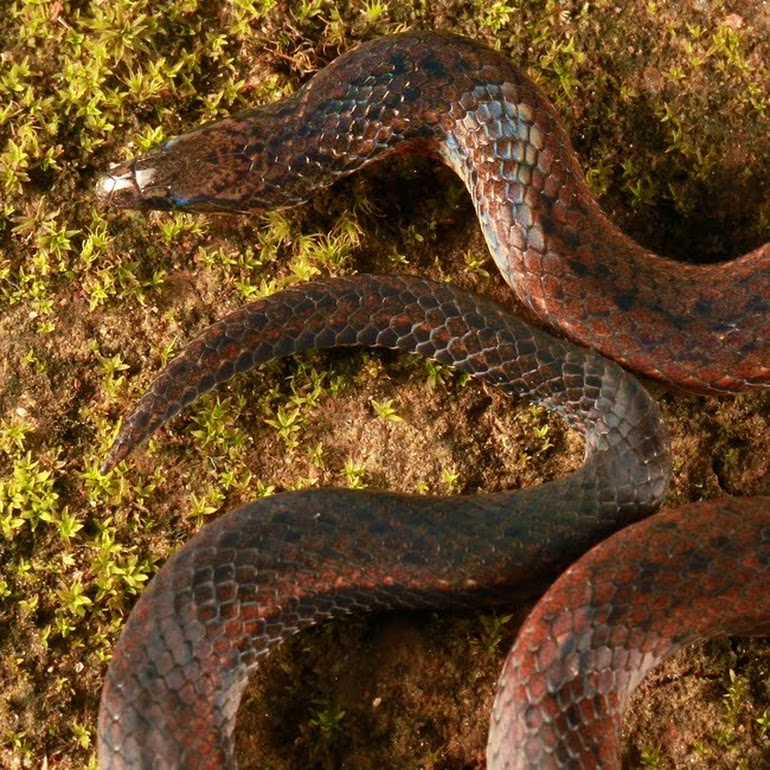![]() |
Nymphargus manduriacu
Guayasamin, Cisneros-Heredia, Vieira, Kohn, Gavilanes, Lynch, Hamilton & Maynard, 2019
|
Abstract
We describe a new glassfrog from Río Manduriacu Reserve, Imbabura Province, on the Pacific slopes of the Ecuadorian Andes. The new species can be distinguished from most other glassfrogs by having numerous yellow spots on the dorsum and lacking membranes among fingers. Both morphological and molecular data support the placement of the species in the genus Nymphargus. We present a new mitochondrial phylogeny of Nymphargus and discuss the speciation patterns of this genus; most importantly, recent speciation events seem to result from the effect of the linearity of the Andes. Finally, although the new species occurs within a private reserve, it is seriously endangered by mining activities; thus, following IUCN criteria, we consider the new species as Critically Endangered.
![]() |
Figure 3: Nymphargus manduriacu sp. nov. in life.
(A)–(C) Adult male, holotype, ZSFQ 0466. (D)–(F) Adult female, paratype, ZSFQ 0462. |
![]() |
| Figure 4: Life stages of Nymphargus manduriacu sp. nov. (A) Egg clutch (ZSFQ 467). (B) Metamorph (ZSFQ 618). |
![]() |
Figure 5:Nymphargus manduriacu sp. nov. and similar species.
(A) Nymphargus manduriacu, Reserva Río Manduriacu, Ecuador, uncollected. (B) N. buenaventura, Cascadas de Manuel, Cantón El Guabo, Provincia El Oro, 800 m, Ecuador, DHMECN 10982, photo by Juan Carlos Sánchez. (C) N. luminosus, Quebrada la Honda y La Amarill, Verada Venados Arriba, Municipio de Frontino, Departamento de Antioquia, Colombia, MAR 3576, photo by Marco Rada. (D) N. spilotus, Parque Nacional Natural Selva de Florencia, Colombia, JD 060, photo by Jesse Delia. |
![]() |
| Nymphargus manduriacu sp. nov., Reserva Río Manduriacu, Ecuador, uncollected. |
Nymphargus manduriacu new species
Common names. English: Manduriacu glassfrog.
Spanish: Rana de Cristal de Manduriacu.
Diagnosis. Nymphargus manduriacu sp. nov. is distinguished from most glassfrogs by lacking webbing between inner fingers and having, in life, a grayish green dorsum with numerous yellow spots, which sometimes are surrounded by an ill-defined black ring (i.e., false ocelli). On the Pacific slopes of the Ecuadorian and Colombian Andes, there are very few species that share the two aforementioned traits with N. manduriacu sp. nov.; these species are: N. buenaventura, N. ignotus, N. spilotus, and N. luminosus. Differences among these species are summarized in Table 1 and Figs. 5 and 6. The sister species of N. manduriacu sp. nov. is N. balionotus, which is easily differentiated by its unique dorsal color pattern, a green dorsum with several black and occasionally yellow to cinnamon blotches (Duellman, 1981; Arteaga-Navarro, Bustamante & Guayasamin, 2013). Also, the uncorrected p genetic distance between N. manduriacu sp. nov. and N. balionotus is 6.4–6.7% for the 12S and 16S concatenated matrix.
....
Evolutionary relationships of the new species. Given the gene and taxon sampling of our study, Nymphargus manduriacu sp. nov. is sister to N. balionotus. The latter taxon was considered to be as incertae sedis within the subfamily Centroleninae (Guayasamin et al., 2009). Here, we formally place Centrolenella balionota Duellman, 1981 in the genus Nymphargus sensu Guayasamin et al., 2009. Nymphargus manduriacu sp. nov. and N. balionotus are endemic to the Pacific slopes of the northern Andes, and are found syntopically at RMR.
Distribution. Nymphargus manduriacu is only known from a few nearby streams within the Río Manduriacu Reserve, Imbabura province, on the Pacific slopes of the Andes of Ecuador (Fig. 1). Based on these limited records, the species occupies a narrow elevational range of 1,215–1,242 m.
Conservation status. We recommend that N. manduriacu should be considered as Critically Endangered, following IUCN (2001) criteria B2a (known to exist from a single locality) and B2biii (continuing decline, observed, inferred or projected, in area, extent and/or quality of habitat). The main threats for the species are habitat destruction and contamination associated with cattle ranching, agriculture and, most seriously, mining activities (see Discussion; Fig. 8). Although RMR is still poorly surveyed, northwestern Ecuador has been the target of intense herpetological research (e.g., Lynch & Duellman, 1973, 1997; Arteaga-Navarro, Bustamante & Guayasamin, 2013; Arteaga et al., 2016), including areas nearby RMR (i.e., Reserva Los Cedros; Hutter & Guayasamin, 2015); thus, the restricted distribution of the new species is, most likely, real.
Etymology. The specific epithet “
manduriacu” is a noun in apposition and refers to the type locality of the species,
Río Manduriacu Reserve, a conservation area managed by Fundación EcoMinga (
ecomingafoundation.wordpress.com).
Conclusions:
We provide morphological, genetic, and acoustic evidence that support the validity of a new species, Nymphargus manduriacu. Also, we infer a new mitochondrial phylogeny of the genus Nymphargus that allows us to reveal speciation patterns in this taxon, mainly that recent speciation events in this genus seem to be heavily influenced by the linearity of the Andes and dry river-valleys that are run transversal to this mountain range. Finally, the new species is considered as Critically Endangered because of its restricted distribution, habitat destruction and contamination associated with cattle ranching, agriculture and, most seriously, mining activities. At Río Manduriacu Reserve, mining has become one of the most dangerous threats to biodiversity, especially to species with highly restricted distributions.
Juan M. Guayasamin, Diego F. Cisneros-Heredia, José Vieira, Sebastián Kohn, Gabriela Gavilanes, Ryan L. Lynch, Paul S. Hamilton and Ross J. Maynard. 2019. A New Glassfrog (Centrolenidae) from the Chocó-Andean Río Manduriacu Reserve, Ecuador, Endangered by Mining.
PeerJ. 7:e6400. DOI:
10.7717/peerj.6400

































































